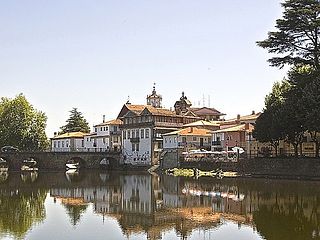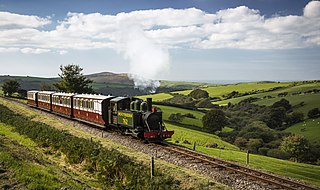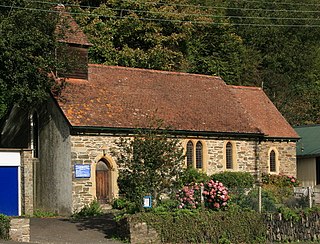
Exmoor is loosely defined as an area of hilly open moorland in west Somerset and north Devon in South West England. It is named after the River Exe, the source of which is situated in the centre of the area, two miles north-west of Simonsbath. Exmoor is more precisely defined as the area of the former ancient royal hunting forest, also called Exmoor, which was officially surveyed 1815–1818 as 18,810 acres (7,610 ha) in extent. The moor has given its name to a National Park, which includes the Brendon Hills, the East Lyn Valley, the Vale of Porlock and 55 km (34 mi) of the Bristol Channel coast. The total area of the Exmoor National Park is 692.8 km2 (267.5 sq mi), of which 71% is in Somerset and 29% in Devon.

The Tâmega or Támega is a river in Galicia, Spain and Portugal. It begins its course near Verín, Galicia, Spain, and flows to Portugal in the provinces of Trás-os-Montes and Douro Litoral.

Lynton is a town on the Exmoor coast in the North Devon district in the county of Devon, England, approximately 17 miles (27 km) north-east of Barnstaple and 18 miles (29 km) west of Minehead, and close to the confluence of the West Lyn and East Lyn rivers.

Lynmouth is a village in Devon, England, on the northern edge of Exmoor. The village straddles the confluence of the West Lyn and East Lyn rivers, in a gorge 700 feet (210 m) below Lynton, which was the only place to expand to once Lynmouth became as built-up as possible. The villages are connected by the Lynton and Lynmouth Cliff Railway, which works two cable-connected cars by gravity, using water tanks.

The Fuji River is a river in Yamanashi and Shizuoka Prefectures of central Japan. It is 128 kilometres (80 mi) long and has a watershed of 3,990 square kilometres (1,540 sq mi). With the Mogami River and the Kuma River, it is regarded as one of the three most rapid flows of Japan.

The Lynton and Barnstaple Railway (L&B) opened as an independent railway in May 1898. It was a single track, 1 ft 11+1⁄2 in narrow gauge railway and was slightly over 19 miles (31 km) long running through the rugged and picturesque area bordering Exmoor in North Devon, England. Although opened after the Light Railways Act 1896 came into force, it was authorised and constructed prior to that act. Therefore, as with all other railways, it was authorised under its own Act of Parliament and built to higher standards than similar railways of the time. In the United Kingdom it was notable as being the only narrow gauge line required to use main-line standard signalling. For a short period the line earned a modest return for shareholders, but for most of its life the L&B made a loss. In 1923, the L&B was taken over by the Southern Railway, and eventually closed in September 1935.

The Lynton and Lynmouth Cliff Railway is a water-powered funicular joining the twin towns of Lynton and Lynmouth on the rugged coast of North Devon in southwest England.
Project Cumulus was a 1950s UK government initiative to investigate weather manipulation, in particular through cloud seeding experiments. Known jokingly internally as Operation Witch Doctor, the project was operational between 1949 and 1952. A conspiracy theory has circulated claiming that the Lynmouth Flood was caused by Project Cumulus. This claim is still ultimately unproven, and weather patterns have shown similar floods dating back to both the 18th and 19th centuries throughout Northern Wales and the UK.

Barbrook is a village in Devon, England. It is close to the source of the West Lyn River.

The East Lyn is a river which rises high in Exmoor, in the English county of Somerset. It flows through the East Lyn Valley in Devon.
A landslide dam or barrier lake is the natural damming of a river by some kind of landslide, such as a debris flow, rock avalanche or volcanic eruption. If the damming landslide is caused by an earthquake, it may also be called a quake lake. Some landslide dams are as high as the largest existing artificial dam.

The Nagashima Dam is a dam on the Ōi River, located in Kawanehon Town, Haibara District, Shizuoka Prefecture on the island of Honshū, Japan.

The Lyn and Exmoor Museum is a small museum in Lynton, Devon, England, housed in the town's oldest surviving domestic dwelling, a Grade II listed, whitewashed, stone cottage.
The Lynmouth Flood occurred on the night of the 15–16 August 1952, principally affecting the village of Lynmouth, in north Devon. A storm with heavy rainfall, combined with already saturated soil and flood debris, led to the flooding of the village and a total loss of 34 lives.
East Lyn Valley is a valley of Exmoor, covering northern Devon and western Somerset, England.

Malmsmead is a hamlet on the border between the English counties of Devon and Somerset. The nearest town is Lynton, which lies approximately 4.7 miles (7.6 km) west of the hamlet. The hamlet is situated in the Doone Valley within the Exmoor National Park.

The Secret of Crickley Hall is a 2006 supernatural thriller novel by the British writer James Herbert.

Lynton Village railway station is a station in Lynton, Devon, England served by the Lynton and Lynmouth Cliff Railway, a water-powered funicular railway.
Lynmouth Bay railway station is a station in Lynmouth, Devon, England, served by the Lynton and Lynmouth Cliff Railway, a water-powered funicular railway. The station has two platforms, a ticket booth, not an office, a bench and plenty of room. It opened in 1890.

Lynton and Lynmouth is a civil parish in the North Devon district of Devon, England. The parish is named after its two main settlements of Lynton, which stands on a plateau above the Glen Lyn Gorge, and Lynmouth which lies at the foot of the gorge where the West Lyn River and East Lyn River converge and then meet the sea. The two are connected by the Lynton and Lynmouth Cliff Railway, a water-powered funicular railway.















